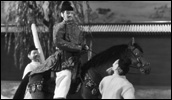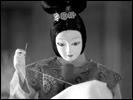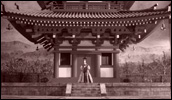The Book of the Dead
- Year
- 2005
- Original title
- Shisha no Sho
- Japanese title
- 死者の書
- Alternative title
- The Book of a Dead Person
- Director
- Cast
- Running time
- 70 minutes
- Published
- 23 April 2007



by Dean Bowman
Like Akira Kurosawa, Kihachiro Kawamoto started his career in Toho studios in the turbulent years immediately following the Pacific War. It was there, as an art designer, that he became schooled in the cinematic medium by working alongside such figures as Teinosuke Kinugasa, Shiro Toyoda and Mikio Naruse.
But Kawamoto was to choose a different route from the young Kurosawa, turning to animation in order to pursue his lifelong love of traditional puppet and doll making. Having trained under the father of Japanese stop-motion animation Tadahito Mochinaga in 1953, Kawamoto has been quietly and persistently making puppet animations for over half a century now. He remains most famous in Japan for creating the puppets for the much-loved historical television series Romance of the Three Kingdoms (Sangokushi, 1982-1984), but as an independent director and producer he has amassed a body of short films that demonstrates a keen artistic vision. The Book of the Dead, only his second full-length feature film, has been something of a long-term ambition, constantly deferred through lack of funds. The fact that Kawamoto has finally realised it is a testament to his tenacity and creative longevity.
Despite holding the lofty sounding position of president of the Japan Animation Association, Kawamoto's independent productions, often funded through a plethora of sources (witness the endless credits of The Book of the Dead), still struggle to compete against the more commercial and competitive world of anime, the mainstream of Japanese animation. Consequently his name is unknown outside of Japan by either obsessive manga-heads or art film fanatics, unlike that of his more famous compatriot, Hayao Miyazaki, who has recently catapulted the medium once more into the international spotlight, reprising the phenomenal success enjoyed by Katsuhiro Otomo's Akira in 1988.
Such a comparison is not ungrounded given that Kawamoto and Miyazaki are both interested in using animation to explore and transmit serious messages to their audiences, whilst fully exploiting the medium's intrinsically poetic qualities. For instance many of Kawamoto's films, like Miyazaki's most recent endeavour Howl's Moving Castle (2004), contain strong antiwar themes, such as his 1988 piece To Shoot Without Shooting. In terms of style and approach, however, the two could not be more different. Kawamoto's work, still crying out for discovery despite recent retrospectives at the Karlovy Vary Film Festival (2005) and the Berkeley Art Museum (2006), demonstrates that there is a tantalising other world of animation in Japan beneath the veneer of what is widely known as anime.
Miyazaki's international appeal was certainly aided by his adoption of a style that was partway between Japanese and western sensibilities - no bug-eyed blue-haired cuties here but recognisably human characters who precariously make contact with fantasy worlds - making him something of a Kurosawa of the anime world; drawing on western fairytales like Alice in Wonderland just as Kurosawa modelled his most iconic works on the westerns of John Ford. Kawamoto, on the other hand, has kept his focus on traditional Japanese narratives and stylistic elements setting his stories in complex historical contexts and taking influences directly from Noh and Kabuki theatre. Miyazaki also benefited from sticking to traditional hand-drawn animation techniques, when Disney were abandoning the form that they had presided over for so long, making his work the Mecca for disillusioned western audiences searching for something more 'innocent' (although Miyazaki's pure style often disguises a more mature depth). In contrast, Kawamoto's embracing of puppet animation is far more imbedded in a culturally specific Japanese tradition of Bunraku puppet theatre, a form that doesn't have a strong parallel in the western consciousness beyond the crass sea-side exploits of Punch and Judy and that lifeless symbol of American consumerism, Barbie, and her many clones. The art form of Bunraku was founded in Osaka in 1684, perhaps as a reaction to Kabuki theatre from which it borrowed many of its narratives, and set about erasing the performance of the actor, laying the focus instead upon the written word as loyally interpreted by a band of self effacing black-suited puppeteers. Given how little Kawamoto strives for the spotlight with his modestly beautiful productions, he can certainly be seen to be operating in this tradition.
Despite the cultural specificity of his work, which might act as a barrier to the kind of popular appeal Miyazaki has enjoyed often in spite of his rather abstract approach to narrative, it is nonetheless fitting that The Book of the Dead was premiered at the Karlovy Vary Film Festival during a retrospective of his work in 2005. In 1963 Kawamoto studied for a year in Prague under the Czech animator Jiri Trnka (The Hand), a period that was to cement his passion for the medium and exert a considerable influence on his style. In particular his earlier short films, such as The Travel, clearly demonstrate his Czech mentor's highly metaphorical brand of East-European surrealism. Kawamoto speaks humbly about his formative experience in Prague at the tender age of 38, saying it was the first time he truly understood what a puppet was. He recalls receiving a letter from Trnka: 'he wrote that puppets are the one thing that transcend nationality, race and religion. So he wrote that it would be his pleasure to welcome me to Czechoslovakia to study puppet animation under him'. The Book of the Dead undoubtedly seeks this state of transcendence in spite of, or even because of, its Buddhist subtexts.
Set in the Nara period (AD 710-784), just after the introduction of Buddhism from China, The Book of the Dead is a moral tale with supernatural elements, which bears similarities with that great period ghost story Ugetsu Monogatari by Kenji Mizoguchi. It follows Iratsume, the devout and noble daughter of the second house of the Fujiwara clan, who has taken upon herself the rather futile task of transcribing 1000 copies of the Amida Sutra. On the day of the Autumn Equinox, after working day and night for over a year and suffering from severe fatigue, she hallucinates seeing the figure of the Buddha radiantly shining over the peak of the holy Mt Futakami. Without any awareness of her actions, or the storm that rages outside, she sets out from the house as though possessed, and her journey takes her to a sacred temple.
In this space between the earthly and spiritual realms begins a Shakespearian tale of mistaken identities, which fluctuates between longing and repression, death and life. The ghost of prince Otsu, assassinated many years ago by the emperor's widow in a court intrigue, believes Iratsume to be her great aunt Mimimo no Toji, whose eyes met his as he was about to be beheaded by Iware pond. Since that encounter prince Otsu has developed a 'terrifying', yearning attachment to the secular world, and so his corpse wanders the land seeking his unrequited love, calling for her to bear him a child that may speak his name. Meanwhile Iratsume, whose devoutness has led her to abandon the world in her search for the divine, despite the frustration of her many suitors, mistakes Otsu's festering pale flesh for the pure manifestation of the Buddha. Every time Otsu makes his advance to her bedside, Iratsume dutifully chants the Amida Sutra in anticipation of her blissful attainment of satori, which, much to her frustration, only seems to scare away her would be lover. Eventually Iratsume endeavours to construct a large cloak to keep her beloved Buddha/Otsu warm in the winter and paints upon it, as the temple's inhabitants look on in disbelief, an elaborate mandala occupied by thousands of bodhisattvas.
Kawamoto's stated intention in creating The Book of the Dead was to 'heal those innocent people who have died in recent wars'. Full of Buddhist themes about suffering and its release, the film is thus something of a prayer addressed to a world in turmoil. The film's moral landscape warns against both an overt attachment to the divine or the secular worlds. Instead its final moments, in which Iratsume sheds a tear after her completion of the richly adorned mandala and walks out of the room until her corporeal form is consumed by sunlight, seems to suggest that one should live for the moment and attempt to find a beauty therein without worrying so much about future redemption (Iratsume's feverish copying of the Amida Sutra) or desperately holding on to fleeting past happiness (Otsu's attempt to find Mimimo no Toji). The mandala, an elaborate painting central to Buddhist belief, fits this theme perfectly as it represents a microcosm of the universe and/or Nirvana and is a symbol that unifies the self with the world. Although the ending may seem strangely inconclusive for a moral tale, the presence of the mandala in the final moments unifies the work on a deeper metaphysical level allowing it to transcend the limitations of the narrative, many elements of which are left deliberately undeveloped, particularly the subplot of the aging romantic general Yakomochi whose pursuit of Iratsume ends up being in vain.